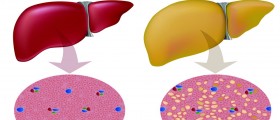
Many factors contribute to the creation of lacerated liver,and in this text, we will see which they are. They can be caused by penetrativeinjury, blunt trauma and other injuries of the liver. The problem we aretalking about can be verified by an imaging test. Liver is very important organ because it is responsible for blood glucose level regulation, bloodfiltering, production of urea, amino acids production and bile juice secretion.But the liver has a position in the body which is susceptible to injuries and thisis why numerous cases of liver injury are reported throughout the year. Spleeninjuries are the most common ones but liver injuries are just behind, and in these cases,medical attention and treatment are needed.
Causes
Accidental injury is the most common way of injuring a liver. Other possiblesituation during which the liver can be damaged include rib damage or fracture (whichmostly occurs among people who are into extreme sports), accidents with motor vehicle(mostly blunt trauma injuries are caused) and accidents with knife or some other sharp object (which cause lacerations due to penetration). The severity of theproblem can be graded from one to six, with one being the mildest one and sixthe most serious one.
Symptoms
Bleeding is the most common symptom of liver laceration but other symptomsthat can be experienced as well are abdominal region stiffness, guarding pain,tenderness in the upper right quadrant and discomfort in the right shoulder.The severity of the symptoms will depend on the severity of the injury.Symptoms of a shock will be experienced if bleeding is excessive.
Lacerated liver is usually diagnosed initially with a CT scan, which has to be done by aqualified physician. But some other tests may be used as well. Some of them arefocal assessment sonogram in trauma and MRI scan. The exact severity of theproblem will be discovered with the help of tests such as liver function test,liver enzyme test and blood test.
Treatment
Serious problems will require immediate medical attention but in mild cases, the patientwill be monitored for two or three days during which any improvement will benoted. During the monitoring period, the levels of hematocrit and hemoglobin willbe measured on regular basis. For serious cases, a surgery will have to beperformed, which will also have to be done if the levels of hematocrit andhemoglobin decrease.More than 80% of those with liver lacerations do not bleed and in such cases the patient should recover on its own. The assessment of the severity of theproblem must be done in order to avoid unnecessary surgery. When a patient isrecovering, bed rest will have to follow, and it will last from three to fourmonths. During this period, the patient will have to make some lifestyle changes andrestrain from more demanding activities in order to heal faster.

















Your thoughts on this
Loading...